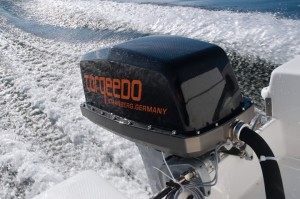The electric alternative
Although gasoline-powered outboards and electrically powered outboards might seem like polar opposites, both have the same mission: To produce more power with less.
For the Germany-based electronic-outboard manufacturer Torqeedo, the goal of electronically powered propulsion has advanced as the technology behind lithium batteries has dropped in price and grown in potential.
Torqeedo’s four product lines, which vary from 1.5 to 10 equivalent horsepower, are embraced by vessels including kayaks and large sailboats.
Further exemplifying the increased potential of electricity and outboard engines, Torqeedo will produce an 80-horsepower equivalent engine next year, according to Friedrich Böbel, founder of Torqeedo.
Using electronically commuted motors, Böbel said its engines are able to power large vessels due to torque characteristics that are superior to gasoline. Today, Torqeedo motors with three equivalent horsepower are found on 2-ton sailboats.
The manufacturer’s electric engines have maximum torque at zero RPMs, compared to a gasoline engine where little to no torque is created at low RPMs. And with electrical, the torque characteristic stays relatively flat, so even at 6000 RPMs, torque characteristics remain strong.
Since gasoline engines have little torque at low RPMs, they are forced to use comparatively smaller propellers, which cause a loss in overall efficiency. Böbel said Torqeedo’s initial torque allows for larger propellers with greater pitch, creating great thrust and maneuverability.
Top speed is not comparable to its gasoline-powered counterparts, but Böbel said the money saved by ditching gas is attractive to boaters who are on the water 100 or more days a year. In fact, he believes electric mobility will prove even more attractive on the water than on the highways.

First, Böbel said boaters do not have the same range concerns as drivers who travel hundreds of miles. Combined with the fact that obtaining gas on the water is more expensive than at a gas station, and Böbel says consumers are starting to compare the price of gas to the cost of running a Torqeedo engine, which is currently about 90 cents per watt hour.
“With every cent per watt hour getting cheaper, it is becoming more and more sensible to switch to electric,” Böbel said.
The main barrier to overcome for Torqeedo has been price. Although improving, the lithium batteries powering the engine are expensive, and despite the gas motor and electric motor being comparable in cost, the money saved on gasoline needs to compensate for the battery cost.
“For someone who goes boating 10 times a year, it won’t make sense on a pure cost-benefit basis, and it won’t make sense in even the next five years. But someone who boats 150 times a year should switch tomorrow,” Böbel said.
What will be possible as early as next year is more horsepower. Böbel said Torqeedo will take advantage of the decreasing costs behind batteries and transmitters to make an 80-horsepower electric outboard at price points unfathomable three years ago.
Since it arrived stateside in 2006, the company’s revenue has grown by 30 percent each year, including a 70-percent increase in the past year. Böbel said its company has large growth goals with its affordable arrival in the 80-horsepower market.
“We are not interested in making toys that please one or two millionaires and get us press coverage,” Böbel said. “We are looking to please the mass market.”
Note: This story is a sidebar within Perfect Performance.





I recently tested the new Campion E-Fusion 180 HP all electric outboard. It drove an 18 footber regular Campion production boat at 50 MPH. Got onto the plane is a hair under three seconds, ran for just more than two hours at 40 mph before recharging was required.